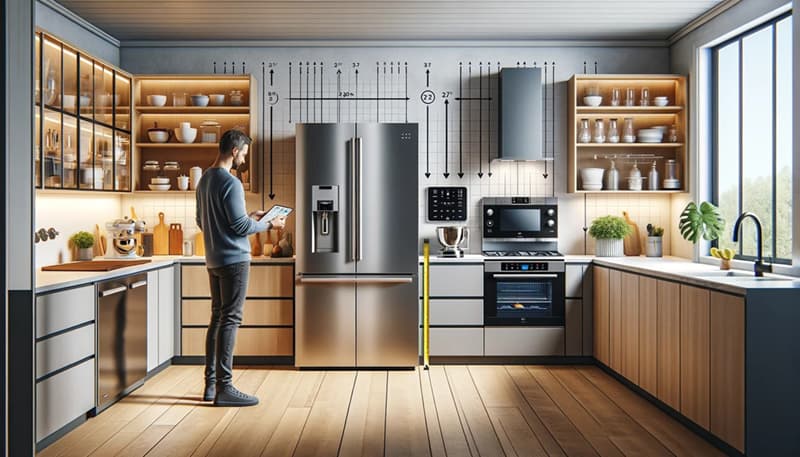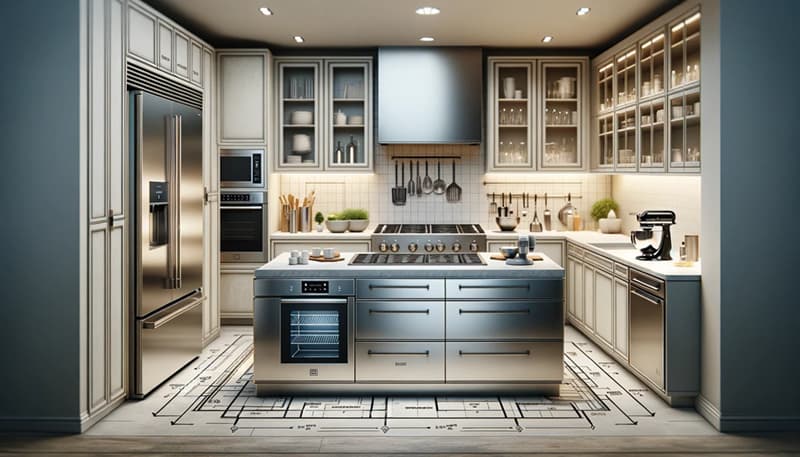Your kitchen is likely the most used room in your home. As the hub for cooking, baking, cleaning, food storage and more, having durable and efficient kitchen appliances suited to your lifestyle is extremely important. From keeping ingredients fresh to whipping up easy weeknight dinners or celebrating holidays with delicious feasts, you rely on major appliances like the refrigerator, stove and dishwasher as well as handy countertop gadgets like the air fryer and blender.
With so many options, brands and features to evaluate, selecting the ideal appliances can be overwhelming. This comprehensive guide to choosing kitchen appliances covers everything from setting your budget and measuring your space to comparing top brands and finding the best sales. Follow these tips and discover the appliances that are perfect for your needs whether renovating your kitchen or just replacing old appliances that have seen better days.

What to Consider When Choosing Kitchen Appliances?
Before browsing the aisles, take time to carefully consider what you need and want from new appliances. Keep these factors in mind while evaluating different models:
Your Budget
Your budget plays a major role in appliance selection. Create a realistic budget that considers:
- Purchase price: Costs can range dramatically based on brand, size, features and promotions. Browse prices both locally and online.
- Installation and haul away costs: Factor in delivery fees plus expenses for installing new appliances like gas line work. There also may be haul away fees for removing old appliances.
- Operating costs: Choose energy-efficient kitchen appliances to save significantly on utility bills over years of daily use.
Making a smart investment means balancing upfront affordability with long term energy efficiency and durability.
Types of Appliances Needed
Determine which appliances you need to replace or add. Major kitchen appliances typically include:
- Refrigerator
- Stove/oven
- Dishwasher
- Microwave
Also factor in small kitchen gadgets and electrics like:
- Stand mixer
- Food processor
- Toaster/toaster oven
- Coffee maker
- Blender
- Slow cooker
- Air fryer
Evaluate which appliances you use regularly and what new ones could expand your menu options. Remove gadgets taking up precious counter space that rarely get used. Selecting versatile, high-performance kitchen machines suited for your cooking style and household needs helps narrow your options.
Size and Capacity
Evaluate your space, cooking preferences and costs to choose the best fuel source per appliance. Many kitchens incorporate a combination depending on factors like existing electrical/gas hookups.
When considering what size and capacity appliances your kitchen requires, carefully measure the physical space you have available then browse appliance dimensions to find models that will fit well height, width and depth-wise. Evaluate the cubic footage capacity needed for food storage based on your household’s typical grocery hauling and leftover needs. It’s important not to overload a small kitchen with oversized appliances that dominate the space, but you’ll want ample room to avoid frequent overflows.
Consider what oven width and cubic foot capacity is required for baking all your holiday meal dishes or largest casserole recipes as standard ovens usually range from 30-33 inches wide. Similarly, assess what cooktop width makes sense for your pots and pans based on cooking habits, with typical options spanning 30-48 inches wide. Remember to allow for necessary clearances around appliances too for factors like counter/cabinet ventilation.
Take refrigerator configuration and storage differences into account as well since unique freezer locations change total capacity such as bottom freezers offering more fridge space. Meanwhile French door and side-by-side units allow items on eye level but sacrifice some freezer real estate in exchange for convenient external refrigeration systems that foster humidity control. Carefully incorporating measurements for each appliance’s functionality translates to smarter sizing.

Connectivity and Smart Features
Many of the latest appliances incorporate WiFi and app connectivity for added convenience and control. When selecting appliances, consider benefits like:
- Remote monitoring and notifications regarding status or maintenance needs
- Ability to adjust modes and settings from smartphones or voice commands
- Troubleshooting and tech support capabilities
- Potential energy savings from customizing runtimes and temperatures
While connectivity advances come at a cost premium, the long term benefits often balance initial price differences for tech-savvy homeowners. Still focus first on your required basics like capacity and size before selecting smart kitchen appliance options. You can always add on smart accessories later if not standard features.
Appearance and Finish
Today’s appliances make a design statement with unique finishes beyond traditional stainless steel. Options include:
Matte Black Stainless Steel: The understated, anti-fingerprint finish avoids smudges and stands out in bold dark hue.
Textured metals: Horizontal grain, checkerboard or diamond plate etched patterns add dimension.
White and Color: Crisp clean white, classic black or shades like cobalt blue and emerald green inject personalization.
Custom Panel Ready: Accepts custom cabinet face panels for a seamless built-in look.
For contemporary kitchens, professional style stainless ranks timeless. But more budgets now allow mixing metals and colors based on personal style. Just confirm finishes are food safe and durable against scratching, UV light damage or discoloration.
Consider visibility too. Do you want appliances fully integrated behind cabinetry, partially peeking out requiring coordinating panels or full exposure as bold focal points?
Reliability and Durability
When investing in new appliances, longevity should be top of mind. Carefully research reliability ratings and durability from both professional testing agencies and consumer reviews. Consider:
- Repair frequency: Check statistics on reliability versus likelihood of needing service calls for breakdowns.
- Warranty coverage: Look for at least 1-year limited parts and labor coverage. Specialized components may have 5-10 years.
- Brand reputation: Some manufacturers like Miele consistently rate well across high-end models while affordable brands carry more mixed reputations.
- Quality of parts: Well-engineered interiors like refrigeration systems or stove burners last over basic parts.
- Materials used: Metal lasts longer than plastic housing and controls.
While it’s impossible to predict all future issues, choosing reputable brands engineered for the long haul avoids prematurely repeating appliance shopping. When possible, read in-depth kitchen appliance reviews rather than relying just on store samples.
Energy Efficiency
Major appliances present prime opportunities to cut home energy use and costs. Focus on the government’s ENERGY STAR certification when comparing refrigerators, dishwashers, clothes washers and other kitchen appliances. Key aspects to consider regarding savings:
- Energy efficient technology: Inverter driven compressors, variable speed motors and digitally adaptive heat controls minimize energy requirements.
- Insulation: Well insulated units prevent loss of cool or warm air. Door seals and compartments maintain internal climates too.
- Advanced sensors and settings: Options like air fry, steam cook, freezer eco modes and self-cleaning optimize as needed without excess runtime.
- Energy monitoring feedback: Smart appliance connectivity conveys actual usage data to motivate reduced consumption.
While energy efficient models sometimes cost more upfront, the investment pays off through lower utility bills. Plus new incentives, tax credits and rebates help offset initial prices. Depending on usage levels, an ENERGY STAR certified appliance returns the price difference in as little as a year through savings.
Stainless Steel Appliances
Stainless steel appliances are a popular choice for kitchens due to their sleek and modern appearance, as well as their durability and resistance to rust and corrosion. These appliances are not only stylish but also easy to clean and maintain, making them a practical choice for any kitchen. With their ability to seamlessly blend in with various design styles, stainless steel appliances are a timeless option for any home. Whether you’re looking for a refrigerator, dishwasher, range, or microwave, stainless steel appliances are a reliable and high-quality choice that can elevate the look of your kitchen while providing long-lasting performance.
Refrigerators
Refrigerators come in a variety of configurations and storage systems to accommodate needs:
- Top freezer: Budget friendly style with freezer atop fresh food compartment. Require bending down for frozen items. Bestselling affordable option.
- Bottom freezer: Freezer on bottom places frequently accessed fresh items at eye level. Limited freezer space.
- Side-by-side: Paired doors split freezer and fridge capacity. Wider formats. Incorporates ice/water dispensers.
- French door: Bottom freezer couples with double width refrigerated doors. Delivers storage flexibility and accessibility.
- Counter depth: Shallower standard depths for placement flush with cabinets. Require precise kitchen dimensions.
- Built-in: Integrated behind cabinet facades with only chilled panel visible. Ultimate seamless appearance.
Important aspects to compare include shelf configurations, humidity controlled crisper and deli drawers, adjustable door bins, ice makers and lighting. Consider family habits and ergonomics identifying optimum chilling appliances.
Stoves and Ovens
Stoves and ovens for passionate home chefs deliver flexibility and precision across all cooking methods:
Cooktops
- Electric: Smooth glass surface hides below heating units with options like induction, radiant, halogen and coil elements. Most affordable purchase price.
- Gas: Open flame range tops allow adjusting heat rapidly and reaching hotter temperatures ideal for stir fry dishes and searing meat. Requires fuel line connection and external ventilation.
- Induction: Electromagnetic energy instantly heats compatible cookware without heating surrounding surface. Boils water lightning fast. Needs special pots/pans.
Ovens
- Conventional: Basic natural air circulation baking oven with average insulation. Multiple rack configurations.
- Convection: Internal fan circulates hot air for accelerated, consistent baking using less energy. Preferred for serious bakers.
- Steam: Combination modes inject steam to keep moisture in meats and baked goods. Great for reheating leftovers too.
- Microwave: Speedy cooking, reheating and defrosting thanks to microwave technology. Use alone or paired with traditional thermal oven.
Additional nice-to-have features include warming drawers, air frying modes, self-cleaning cycles and convection conversion capabilities. WiFi connectivity enables monitoring doneness remotely plus troubleshooting.
When determining your stove and oven needs, consider what and how often you cook then choose durable, quality materials and technology aligned with your lifestyle.
Dishwashers
Dishwashers tackle the dreaded post-meal cleanup so you can spend more time enjoying culinary delights and less time scrubbing plates. When selecting your ideal cleaning appliance, consider:
- Capacity: The number of place settings indicates how many dishes and utensils can be loaded per wash. Look for at least 12 place settings to accommodate average families.
- Cycles: The more cycle options, the better equipped your dishwasher handles varried loads. Look for regular, delicate, express/speed, pots & pans/heavy, eco, rinse only and auto wash cycles.
- Efficiency: Choose ENERGY STAR-certified dishwashers to cut electricity and water usage over hand washing while still delivering sparkling clean dishes.
- Noise: Budget dishwashers can be loud at over 60 decibels but upgraded models drop to ultra-quiet 40 dB ratings, critical for open concept kitchens.
- Material: Higher end models may use stainless steel interiors for increased durability and quieter performance. Many also offer matching exteriors.
- Special features: From soil sensors to determine water needs and steam for stuck-on messes to sanitize modes killing 99% of germs, the latest innovations take the hassle then guesswork out of cleaning up.
When reviewing kitchen appliance reviews for today’s advanced dishwashers, you’ll find they are far from yesteryear’s noisy units leaving behind filmy drinkware. Investing in the right size and cycles saves hours each week so you spend less time pre-rinsing and scrubbing by hand.
Microwaves
Today’s microwaves marry speed and convenience with more advanced cooking functionality to deserve prime real estate on kitchen countertops. When selecting your microwave, factor needs like:
Size: Measure space intended for your unit based on countertops or built-ins. The most compact fit less than one cubic foot capacity while larger families may prefer 1.5-2.0 cu. ft. models.
Wattage: Power equates to efficiency with most models ranging 900-1200 watts. Higher wattage delivers faster reheating times.
Functions: From one-touch instant starts and multiple auto cook programs to inverter technology for constant heat levels, microwaves now offer far more beyond just speeding up convenience foods.
Smart Integration: Higher end models pair perfectly with other appliances thanks to configured trim kits, second oven modes or steam microwave technology improving moistness.
Easy Cleaning: Look for units featuring antimicrobial coatings that resist odor and stain build up as well as fingerprint proof stainless steel (if applicable to your style preferences).
While basic microwaves get the job done, investing in convection and grill capabilities also equips your oven for crispy finishes. Compact and mighty, today’s microwaves multitask far beyond just boiling water or warming up meals in minutes.

Brand Comparison
With so many options for major appliances, it helps to compare reputations and reliability when making investments. Here is an overview of leading brands’ strengths and weaknesses with common considerations:
GE:
- Owned by Haier, a global appliance manufacturer
- Known for affordable, attractive French door refrigerators and free-standing ranges
- Middle tier quality with below average reliability ratings
Samsung:
- Massive global technology corporation
- Specializes in smart appliance connectivity and Flex Duo ovens
- Prone to ice maker issues and touch screen glitches
LG:
- Innovative refrigeration and special features like InstaView knock to see inside
- Stylish designs but mixed reliability and longevity concerns
Whirlpool:
- Largest appliance brand globally
- Best value for price points with decent owner satisfaction
- Can be noisy with questionable durability
Bosch:
- German engineering and quality manufacturing
- Excellent dishwashers and induction cooktop reputation
- Pricey purchases offset by extremely long lifespans
Miele:
- Luxury, commercial grade appliances
- Highest rankings in performance, efficiency, durability
- Significant customer service focus
- Costs justify lifetime value for serious home chefs
Venturing onto showroom floors equips you to assess build quality and usability testing various models firsthand. Balancing budget realities against the long term return on enjoying advanced appliance innovations simplifies deciding the best brand for your kitchen.






